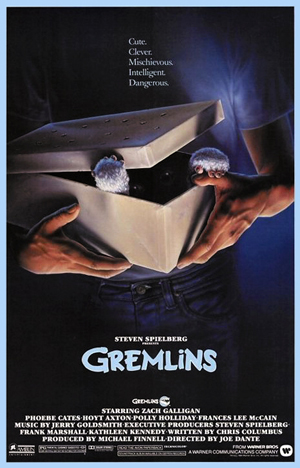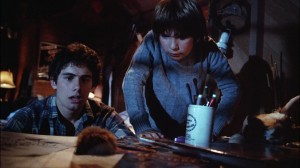In a previous post on Ghostbusters, I wrote about how 1984 was a hell of a summer for movie nerds like myself. On May 23, the highly anticipated Raiders prequel Indiana Jones and the Temple of Doom was released, while the following week saw the release of Star Trek III: The Search for Spock, almost equally anticipated because we’d get to discover whether or not our beloved Spock could be brought back from the dead on the Genesis planet.
 But the summer got really crazy when thirty years ago, on June 8 1984, both Ghostbusters and Gremlins opened on the same day. Back then, if a film didn’t open in the #1 spot, it wasn’t considered “dead on arrival” and even though Ghostbusters prevailed opening weekend, both films went on to become huge hits, each breaking $100 million at the box office that year.
But the summer got really crazy when thirty years ago, on June 8 1984, both Ghostbusters and Gremlins opened on the same day. Back then, if a film didn’t open in the #1 spot, it wasn’t considered “dead on arrival” and even though Ghostbusters prevailed opening weekend, both films went on to become huge hits, each breaking $100 million at the box office that year.
My favorite of all these movies turned out to be Gremlins, directed by Joe Dante, who at the time was rapidly become a favorite director of mine, having previously made Piranha (1978), The Howling (1981) and the “It’s a Good Life” segment in Twilight Zone: The Movie (1983). It was on Twilight Zone that the director began working with composer Jerry Goldsmith, who matched Dante’s insane cartoon-fueled nightmare images with a score featuring police whistles and car horns. This began a collaboration spanning two decades and eight additional feature films.
I’ve always felt an odd connection to Joe Dante’s work, a mind clearly as twisted as my own, probably from watching too many cartoons as a kid — or perhaps more likely from watching too many cartoons as a grown-up.
 Gremlins was the first screenplay of a young writer named Chris Columbus, who of course would go on to direct Home Alone (1990) and the first two films in the Harry Potter series. In the story, young Billy Peltzer (Zach Galligan) is given a creature called a Mogwai as a Christmas gift by his father (Hoyt Axton) with the understanding that three basic rules need to be followed: don’t get it wet, keep it out of bright light and never feed it after midnight. Of course we know these rules will be broken. That’s part of the fun.
Gremlins was the first screenplay of a young writer named Chris Columbus, who of course would go on to direct Home Alone (1990) and the first two films in the Harry Potter series. In the story, young Billy Peltzer (Zach Galligan) is given a creature called a Mogwai as a Christmas gift by his father (Hoyt Axton) with the understanding that three basic rules need to be followed: don’t get it wet, keep it out of bright light and never feed it after midnight. Of course we know these rules will be broken. That’s part of the fun.
Feeding the Mogwai after midnight causes them to be transformed into malevolent, mischievous, nasty creatures. Thus what begins as a “family” film about an delightfully cute Mogwai named Gizmo winds up taking a major shift in tone about the time Billy finds his Biology teacher dead with a hypodermic needle stuck in his ass.
 The creatures themselves, created by Chris Walas, are an amazing achievement in animatronics and puppetry, beautifully photographed by cinematographer John Hora. When Billy’s mom (Frances Lee McCain) battles the Gremlins in her kitchen, the carnage is so spectacular — including a Gremlin exploding in a microwave — it helped contribute to the PG-13 rating going into effect later that year. This is a movie that has breakdancing Gremlins one minute and in the next sequence has Billy’s would-be girlfriend Kate (Phoebe Cates) telling a horrific tale about how her father died trying to climb down the chimney in a Santa Claus outfit.
The creatures themselves, created by Chris Walas, are an amazing achievement in animatronics and puppetry, beautifully photographed by cinematographer John Hora. When Billy’s mom (Frances Lee McCain) battles the Gremlins in her kitchen, the carnage is so spectacular — including a Gremlin exploding in a microwave — it helped contribute to the PG-13 rating going into effect later that year. This is a movie that has breakdancing Gremlins one minute and in the next sequence has Billy’s would-be girlfriend Kate (Phoebe Cates) telling a horrific tale about how her father died trying to climb down the chimney in a Santa Claus outfit.
Gremlins is the kind of film that no one has the balls to make anymore, a film that deftly manages the balance of comedy and horror and mayhem, switching between all of those tones wonderfully. The only film I can think of lately that achieved this kind of crazy balance is the British import, Attack the Block (2011), written and directed by Joe Cornish, about a group of street kids in London taking on an alien invasion, a film that barely got a release in the US. I remain hopeful that more people might discover Attack the Block, with one of its stars (John Boyega) being cast in the new Star Wars movie.
One of the things I love most about Gremlins is the score by Jerry Goldsmith. Back in 1984, buying the soundtrack album to Gremlins turned out to be one of my first major soundtrack disappointments, as it was a “Specially Priced Mini LP” with only four Goldsmith cues. I ended up seeing Gremlins six times in the theater that summer, three for the movie itself and another three times just to hear Jerry’s music. As it turned out, I’d have to wait 27 years for a proper Gremlins soundtrack and finally be able to play my favorite cue, called “The Fountain.”
 In 1983, the year before Gremlins came out, Goldsmith not only wrote four uniquely distinct scores for each of the segments in Twilight Zone: The Movie, he also composed Under Fire which features pan pipes and guitar solos by Pat Metheny, and also Psycho II which has a haunting main theme that suggests innocence rather than horror. I’d definitely been a Goldsmith fan up to that point, but it was around this time that I began to truly appreciate his genius.
In 1983, the year before Gremlins came out, Goldsmith not only wrote four uniquely distinct scores for each of the segments in Twilight Zone: The Movie, he also composed Under Fire which features pan pipes and guitar solos by Pat Metheny, and also Psycho II which has a haunting main theme that suggests innocence rather than horror. I’d definitely been a Goldsmith fan up to that point, but it was around this time that I began to truly appreciate his genius.
As I began to discover new Goldsmith scores and excitedly discover older ones, one thing became clear. With any other film composer, looking over the album cover and being generally familiar with the composer’s previous work, I had a fairly good idea of what the music would probably sound like. But with Jerry Goldsmith I had no earthly clue. From the striking ram’s horn in Planet of the Apes (1968), to the Satanic voices in The Omen (1976), to the serpent in Alien (1979), to the Blaster Beam in Star Trek: The Motion Picture (1979), to the blending of electronics and orchestra and strange cat-like yowls in Gremlins, with a Jerry Goldsmith score there was always a surprise in store.
In July of this year, my favorite composer of all-time will have been gone for ten years. That’s ten whole years without experiencing a new piece of Jerry Goldsmith music, one of those pleasures in life that I miss very much. I suppose in some ways it’s fitting that Jerry’s last film score was for a Joe Dante movie, Looney Tunes: Back in Action (2003). Their magnificent collaboration resulted in some of my favorite Goldsmith scores, including Explorers (1985), Innerspace (1987) and of course Gremlins. I still miss you, Jerry. Thanks for all of the wonderful music you left behind.





Comments